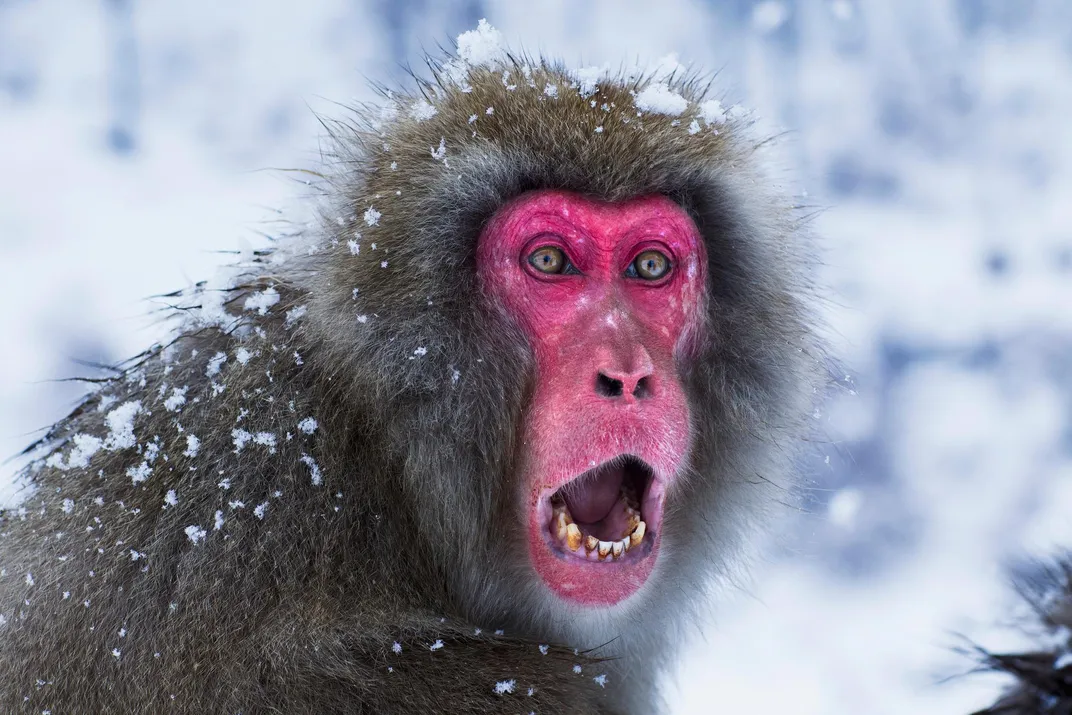Human Ancestors May Have Evolved the Physical Ability to Speak More Than 25 Million Years Ago
Though when primates developed the cognitive abilities for language remains a mystery
/https://tf-cmsv2-smithsonianmag-media.s3.amazonaws.com/filer/9b/5f/9b5fed30-e9dd-4c64-ac33-d535cf040588/gettyimages-1173428284.jpg)
Speech is part of what makes us uniquely human, but what if our ancestors had the ability to speak millions of years before Homo sapiens even existed?
Some scientists have theorized that it only became physically possible to speak a wide range of essential vowel sounds when our vocal anatomy changed with the rise of Homo sapiens some 300,000 years ago. This theoretical timeline means that language, where the brain associates words with objects or concepts and arranges them in complex sentences, would have been a relatively recent phenomenon, developing with or after our ability to speak a diverse array of sounds.
But a comprehensive study analyzing several decades of research, from primate vocalization to vocal tract acoustic modeling, suggests the idea that only Homo sapiens could physically talk may miss the mark when it comes to our ancestors’ first speech—by a staggering 27 million years or more.
Linguist Thomas Sawallis of the University of Alabama and colleagues stress that functional human speech is rooted in the ability to form contrasting vowel sounds. These critical sounds are all that differentiates entirely unrelated words like "bat," "bought," "but" and "bet." Building a language without the variety of these contrasting vowel sounds would be nearly impossible. The research team’s new study in Science Advances concludes that early human ancestors, long before even the evolution of the genus Homo, actually did have the anatomical ability to make such sounds.
When, over all those millions of years, human ancestors developed the cognitive ability to use speech to converse with each other remains an open question.
“What we’re saying is not that anyone had language any earlier,” Sawallis says. ”We’re saying that the ability to make contrasting vowel qualities dates back at least to our last common ancestor with Old World monkeys like macaques and baboons. That means the speech system had at least 100 times longer to evolve than we thought.”

The study explores the origins and abilities of speech with an eye toward the physical processes that primates use to produce sounds. “Speech involves the biology of using your vocal tracts and your lips. Messing around with that as a muscular production, and getting a sound out that can get into somebody else’s ear that can identify what was intended as sounds—that’s speech,” Sawallis says.
A long-popular theory of the development of the larynx, first advanced in the 1960s, held that an evolutionary shift in throat structure was what enabled modern humans, and only modern humans, to begin speaking. The human larynx is much lower, relative to cervical vertebrae, than that of our ancestors and other primates. The descent of the larynx, the theory held, was what elongated our vocal tract and enabled modern humans to begin making the contrasting vowel sounds that were the early building blocks of language. “The question is whether that’s the key to allowing a full, usable set of contrasting vowels,” Sawallis says. “That’s what we have, we believe, definitely disproven with the research that’s led up to this article.”
The team reviewed several studies of primate vocalization and communication, and they used data from earlier research to model speech sounds. Several lines of research suggested the same conclusion—humans aren’t alone in their ability to make these sounds, so the idea that our unique anatomy enabled them doesn’t appear to hold water.
Cognitive scientist Tecumseh Fitch and colleagues in 2016 used X-ray videos to study the vocal tracts of living macaques and found that monkey vocal tracts are speech ready. “Our findings imply that the evolution of human speech capabilities required neural changes rather than modifications of vocal anatomy. Macaques have a speech-ready vocal tract but lack a speech-ready brain to control it,” the study authors wrote in Science Advances.
In a 2017 study, a team led by speech and cognition researcher Louis-Jean Boë of Université Grenoble Alpes in France, also lead author of the new study, came to the same conclusion as the macaque study. By analyzing over 1,300 naturally produced vocalizations from a baboon troop, they determined that the primates could make contrasting proto-vowel sounds.
Some animals, including birds and even elephants, can mimic human voice sounds by using an entirely different anatomy. These amazing mimics illustrate how cautious scientists must be in assigning sounds or speech to specific places in the evolutionary journey of human languages.
“Of course, vocalization involves vowel production and of course, vocalization is a vital evolutionary precursor to speech, “ says paleoanthropologist Rick Potts of Smithsonian’s Human Origins Program, in an email. “The greatest danger is equating how other primates and mammals produce vowels as part of their vocalizations with the evolutionary basis for speech.”
While anatomy of the larynx and vocal tract help make speech physically possible, they aren’t all that’s required. The brain must also be capable of controlling the production and the hearing of human speech sounds. In fact, recent research suggests that while living primates can have a wide vocal range—at least 38 different calls in the case of the bonobo—they simply don’t have the brainpower to develop language.
“The fact that a monkey vocal tract could produce speech (with a human like brain in control) does not mean that they did. It just shows that the vocal tract is not the bottle-neck,” says University of Vienna biologist and cognitive scientist Tecumseh Fitch in an email.

Where, when, and in which human ancestor species a language-ready brain developed is a complicated and fascinating field for further research. By studying the way our primate relatives like chimpanzees use their hands naturally, and can learn human signs, some scientists suspect that language developed first through gestures and was later made much more efficient through speech.
Other researchers are searching backward in time for evidence of a cognitive leap forward which produced complex thought and, in turn, speech language abilities able to express those thoughts to others—perhaps with speech and language co-evolving at the same time.
Language doesn’t leave fossil evidence, but more enduring examples of how our ancestors used their brains, like tool-making techniques, might be used as proxies to better understand when ancient humans started using complex symbols—visual or vocal—to communicate with one another.
For example, some brain studies show that language uses similar parts of the brain as toolmaking, and suggest that by the time the earliest advanced stone tools emerged 2 million years ago, their makers might have had the ability to talk to each other. Some kind of cognitive advance in human prehistory could have launched both skills.
Sawallis says that the search for such advances in brain power can be greatly expanded, millions of years back in time, now that it’s been shown that the physical ability for speech has existed for so long. “You might think of the brain as a driver and the vocal tract as a vehicle,” he says. “There’s no amount of computing power that can make the Wright Flyer supersonic. The physics of the object define what that object can do in the world. So what we’re talking about is not the neurological component that drives the vocal tract, we’re just talking about the physics of the vocal tract.”
How long did it take for our ancestors to find the voices they were equipped with all along? The question is a fascinating one, but unfortunately their bones and stones remain silent.